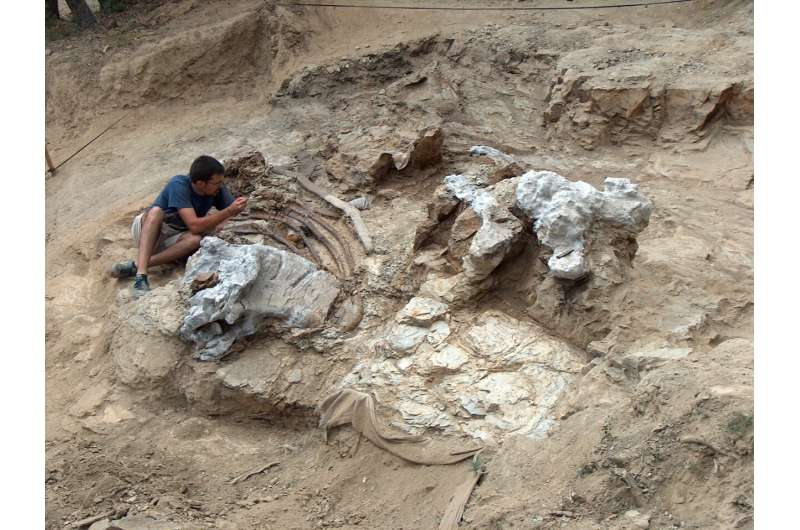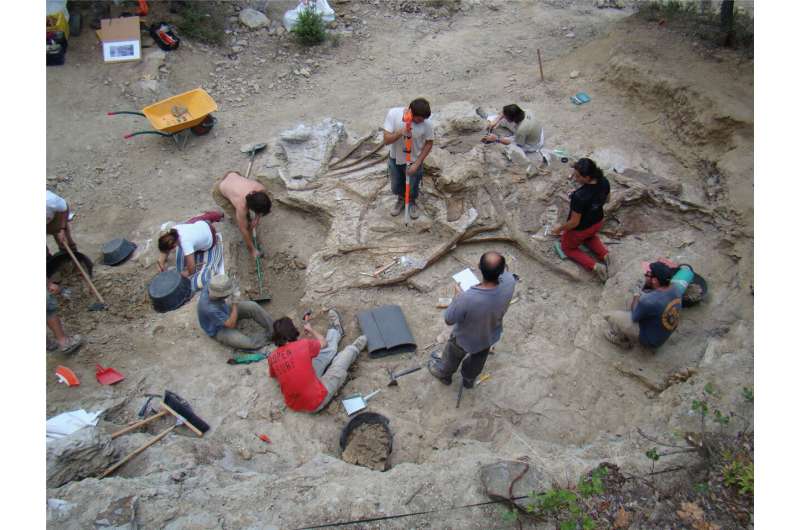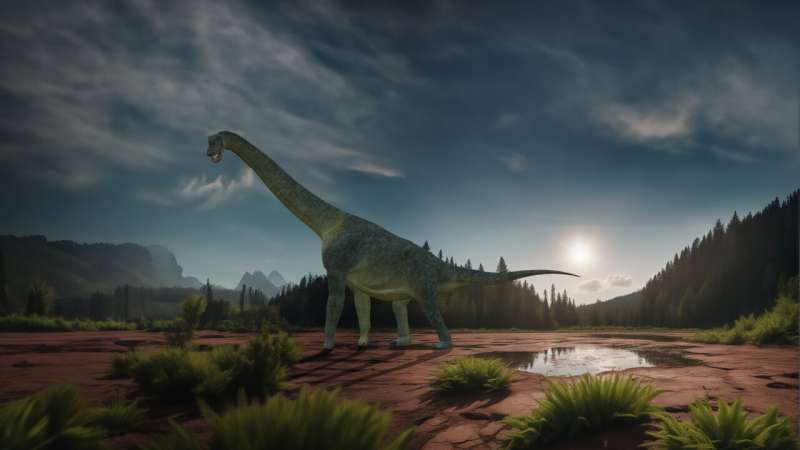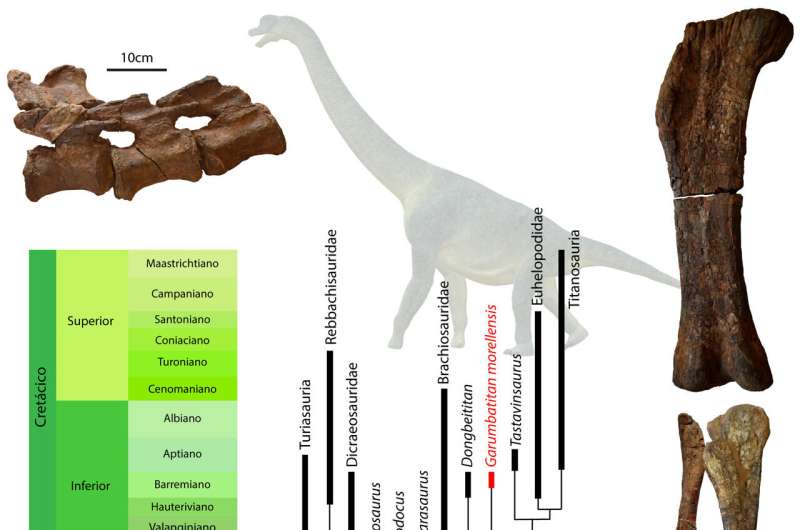This article has been reviewed according to Science X's editorial process and policies. Editors have highlighted the following attributes while ensuring the content's credibility:
fact-checked
peer-reviewed publication
trusted source
proofread
Garumbatitan: A new giant dinosaur in the Lower Cretaceous of the Iberian Peninsula

A new study describes a new sauropod dinosaur that lived in the Iberian Peninsula 122 million years ago. This new species of dinosaur, Garumbatitan morellensis, was described from remains discovered in Morella (Castelló, Spain) and made it possible to expand the diversity of dinosaurs known in one of the best fossil records from the Early Cretaceous in Europe.
The sedimentary deposits that emerge in the region of Els Ports de Morella (Spain) contain an abundant record of dinosaurs from the Early Cretaceous, around 122 million years old. In particular, some of the first dinosaur remains found in Spain were discovered in the Morella region. In recent years, numerous fossils of Mesozoic vertebrates have been found in the vicinity of this location, some of which are extremely relevant, including an important collection of ornithopod dinosaurs, including Morelladon beltrani, and sauropod dinosaurs.
This discovery, by a team of Portuguese and Spanish paleontologists, is described in a paper now published in the prestigious Zoological Journal of the Linnean Society. The new dinosaur species, which has been called Garumbatitan morellensis, belongs to the sauropod group, which is made up of quadrupedal herbivorous dinosaurs with long necks and tails that could reach colossal dimensions.
The remains of this new dinosaur were found and excavated in the sediments that emerge in the Morella locality in 2005 and 2008 in the Sant Antoni de la Vespa fossil-site. In this deposit, one of the largest concentrations of sauropod dinosaur remains from the European Lower Cretaceous was recognized, and in which elements of at least four individuals were identified, three of which belonged to this new species. Sant Antoni de la Vespa thus constitutes one of the key locations for the study of dinosaur faunas in Spain during this period.

"One of the individuals we found stands out for its large size, with vertebrae more than one meter wide, and a femur that could reach two meters in length. We found two almost complete and articulated feet in this deposit, which is particularly rare in the geological record," says Pedro Mocho, leader of this study, paleontologist of Instituto Dom Luiz, Faculty of Sciences of the University of Lisbon (Portugal).
The article now published presents a detailed description of the fossil remains found in Sant Antoni de la Vespa, identifying a set of anatomical characteristics different from other sauropod dinosaurs. Garumbatitan is characterized by the unique morphology of the femur (the upper bone of the leg) and the elements that form the foot. The femur presents a morphology similar to the femora of more modern sauropods from the Late Cretaceous.
This study also analyzes the kinship relationships of Garumbatitan morellensis and other sauropod dinosaurs from the Early Cretaceous of the Iberian Peninsula. Garumbatitan is one of the most primitive members of a group of sauropods called Somphospondyli, which corresponds to one of the most diverse and abundant groups during the Cretaceous and which became extinct at the end of the Mesozoic.

Finally, this study highlights the enormous complexity of the evolutionary history of sauropods from the European Cretaceous, in particular, from the Iberian Peninsula, with species related to lineages present in Asia and North America, as well as some groups related to forms from the African continent. These results suggest the existence of periods of faunal dispersal between these continents.
The future restoration of all fossil materials found in this deposit will add important information to understand the initial evolution of this group of sauropods that dominated dinosaur faunas during the last million years of the Mesozoic era.
"Our study highlights the enormous complexity of the evolutionary history of sauropods from the European Cretaceous—in particular, from the Iberian Peninsula, with species related to lineages present in Asia and North America, as well as some groups related to forms from the African continent. Our results suggest the existence of periods of faunal dispersal between these continents," explains Pedro Mocho.

"The future restoration of all fossil materials found in this deposit will add important information to understand the initial evolution of this group of sauropods that dominated dinosaur faunas during the last million years of the Mesozoic era," adds Francisco Ortega, co-author of this study, Grupo de Biología Evolutiva of the Universidad Nacional de Educación a Distancia (UNED, Spain).
The name of the new species, Garumbatitan morellensis, contains a double reference. On the one hand, Garumbatitan means "the giant of Garumba," as this specimen was found at the base of Mola de la Garumba, one of the highest reliefs in the Els Ports region. On the other hand, the specific name morellensis refers to the location where the deposit is located, Morella.
The fossil remains of Garumbatitan morellensis form part of one of the largest collections of fossil vertebrates from the Iberian Mesozoic deposited at the Temps Museum of Dinosaurs in Morella and which forms part of the Valencian Community Museum Network.
More information: Pedro Mocho et al, New sauropod dinosaur from the Lower Cretaceous of Morella (Spain) provides new insights on the evolutionary history of Iberian somphospondylan titanosauriforms, Zoological Journal of the Linnean Society (2023). DOI: 10.1093/zoolinnean/zlad124
Journal information: Zoological Journal of the Linnean Society
Provided by University of Lisbon




















